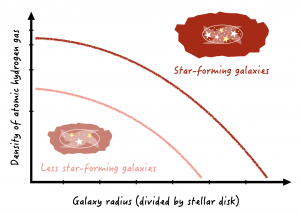Gas location drives star formation in distant galaxies

The red shade shows the atomic hydrogen gas content of the galaxy (figure 2), overlaid on the optical image (figure 1). The atomic gas that is outside the white circle does not contribute significantly to the formation of new stars
Astronomers have found that it is not how much gas a galaxy has, but where that gas is located, that determines whether new stars form.
PERTH, AUSTRALIA, May 21, 2025 /EINPresswire.com/ -- Astronomers have found that it is not how much gas a galaxy has, but where that gas is located, that determines whether new stars form.
Researchers at the International Centre for Radio Astronomy Research (ICRAR) made the discovery about galaxies by studying the gas distribution that helps create stars.
Using CSIRO’s ASKAP radio telescope located at Inyarrimanha Ilgari Bundara, the CSIRO Murchison Radio-astronomy Observatory, researchers explored the gas distribution in about 1,000 galaxies as part of the WALLABY survey.
Lead author Seona Lee, a PhD student at The University of Western Australia node of ICRAR, said the findings give new insights into how stars are born from gas.
While earlier surveys could only map the gas distribution in a few hundred galaxies, the WALLABY survey has successfully mapped the atomic hydrogen gas in a significantly larger sample of galaxies.
The survey revealed that having more gas in a galaxy does not automatically mean it will create more stars. Instead, galaxies that are forming stars usually have a higher concentration of gas in the areas where the stars reside.
“It was very exciting to see a correlation between star formation and where the atomic hydrogen gas is located,” Ms Lee said.
Higher-resolution observations from telescopes like ASKAP, owned and operated by CSIRO, Australia’s national science agency, allowed Ms Lee to measure the location and density of the atomic gas for an unprecedented number of galaxies.
Senior Principal Research Fellow at ICRAR Professor Barbara Catinella, who co-leads the WALLABY survey, said atomic hydrogen gas is the essential ingredient for making stars, in the same way that flour is to a cake.
“While different cakes require different amounts of flour, to bake a cake properly, you focus on the flour that’s in the bowl, not the unused flour left in the package,” Professor Catinella said
“Similarly, understanding how stars are formed requires us to measure the atomic gas where stars are actually forming, rather than considering the total gas content, which includes the unused gas in the outer regions.”
The research showed that being able to conduct more detailed radio observations is key to helping scientists understand how galaxies grow and change over time. The team looked at radio waves and visible light from nearby galaxies to determine the amount of gas in the parts of the galaxy where stars are being born.
“To learn about how stars are formed, we had to measure the atomic hydrogen gas in areas where stars are actively coming to life,” Ms Lee said.
“This is important for figuring out just how much gas is really supporting the creation of new stars.”
This study was published overnight in the Publications of the Astronomical Society of Australia (PASA).
Full link to media release once embargo lifts is available here.
Charlene D'Monte
International Centre for Radio Astronomy Research
+61 468 579 311
email us here
Visit us on social media:
LinkedIn
Instagram
Facebook
YouTube
X
Other
Legal Disclaimer:
EIN Presswire provides this news content "as is" without warranty of any kind. We do not accept any responsibility or liability for the accuracy, content, images, videos, licenses, completeness, legality, or reliability of the information contained in this article. If you have any complaints or copyright issues related to this article, kindly contact the author above.
DMP Unveils Next-Gen Edge AI SoC 'Di1' with Advanced AI Inference & Real-Time 3D Ranging Engine at Computex Taipei 2025
Meatable Showcases Sustainable Meat Innovation at World Expo Osaka 2025
Reconditioned Steel Drum Market Share Analysis to Grow at 4.5% CAGR Through 2035 as Circular Economy Gain Traction | FMI
Kalendarium
Więcej ważnych informacji
 Jedynka Newserii
Jedynka Newserii

 Jedynka Newserii
Jedynka Newserii

Bankowość

Finansowanie Europejskiego Banku Inwestycyjnego wspiera rozwój OZE czy infrastruktury drogowej. Wśród nowych priorytetów bezpieczeństwo i obronność
Od momentu przystąpienia do UE polska gospodarka urosła dwukrotnie – skumulowany wzrost PKB wyniósł 99 proc., a połowa wzrostu wynikała z członkostwa w UE. Duża w tym zasługa Europejskiego Banku Inwestycyjnego, który od 2004 roku przekazał w Polsce 100 mld euro w finansowanie projektów związanych m.in. z efektywnością energetyczną, OZE czy zrównoważonym rozwojem miast. EBI zwiększa też inwestycje w obronność i bezpieczeństwo – w 2024 roku bank zainwestował 300 mln euro w pierwszy polski program satelitarny.
Polityka
Duży udział własności państwowej negatywnie wyróżnia Polskę na tle Europy. Większość Polaków za ograniczeniem wpływu polityków na gospodarkę

Polska negatywnie wyróżnia się na tle krajów UE i OECD pod względem własności państwowej. Państwo kontroluje nie tylko duże, kluczowe dla gospodarki przedsiębiorstwa, lecz również graczy w mniej znaczących sektorach, jak słodycze czy armatura. Zdaniem przedstawicieli FOR „zatruwa” to zarówno gospodarkę, jak i politykę. W badaniach organizacji Polacy wypowiedzieli się proprywatyzacyjnie, choć w przypadku pytań o prywatyzacje dużych firm już nie byli tak zdecydowani.
Transport
Polska jednym z największych rynków aut używanych na świecie. Dwie trzecie kierowców planuje zakup z drugiej ręki

66 proc. konsumentów, którzy w ciągu najbliższych trzech lat chcą zmienić samochód, deklaruje zakup z drugiej ręki – wynika z badania autoDNA. W Polsce na jedno auto nowe, z salonu, przypada pięć używanych. Chociaż rynek wtórny się stopniowo profesjonalizuje, wciąż liczne są nieprawidłowości i próby oszukania kupującego. 81 proc. kupujących deklaruje, że weryfikuje stan auta przed zakupem, ale często jest to bardzo pobieżny proces.
Partner serwisu
Szkolenia

Akademia Newserii
Akademia Newserii to projekt, w ramach którego najlepsi polscy dziennikarze biznesowi, giełdowi oraz lifestylowi, a także szkoleniowcy z wieloletnim doświadczeniem dzielą się swoją wiedzą nt. pracy z mediami.










.gif)

 |
| |
| |
|